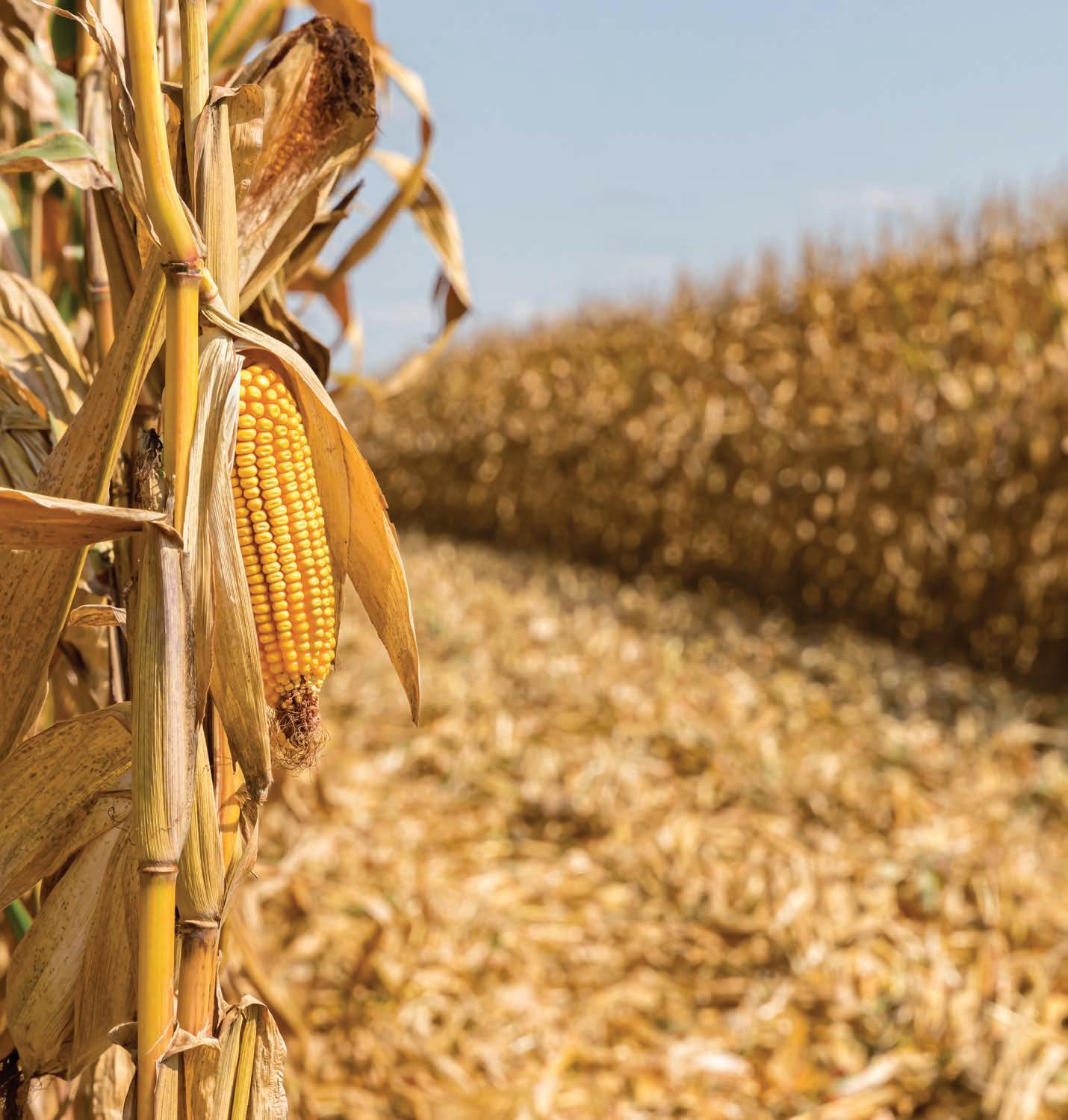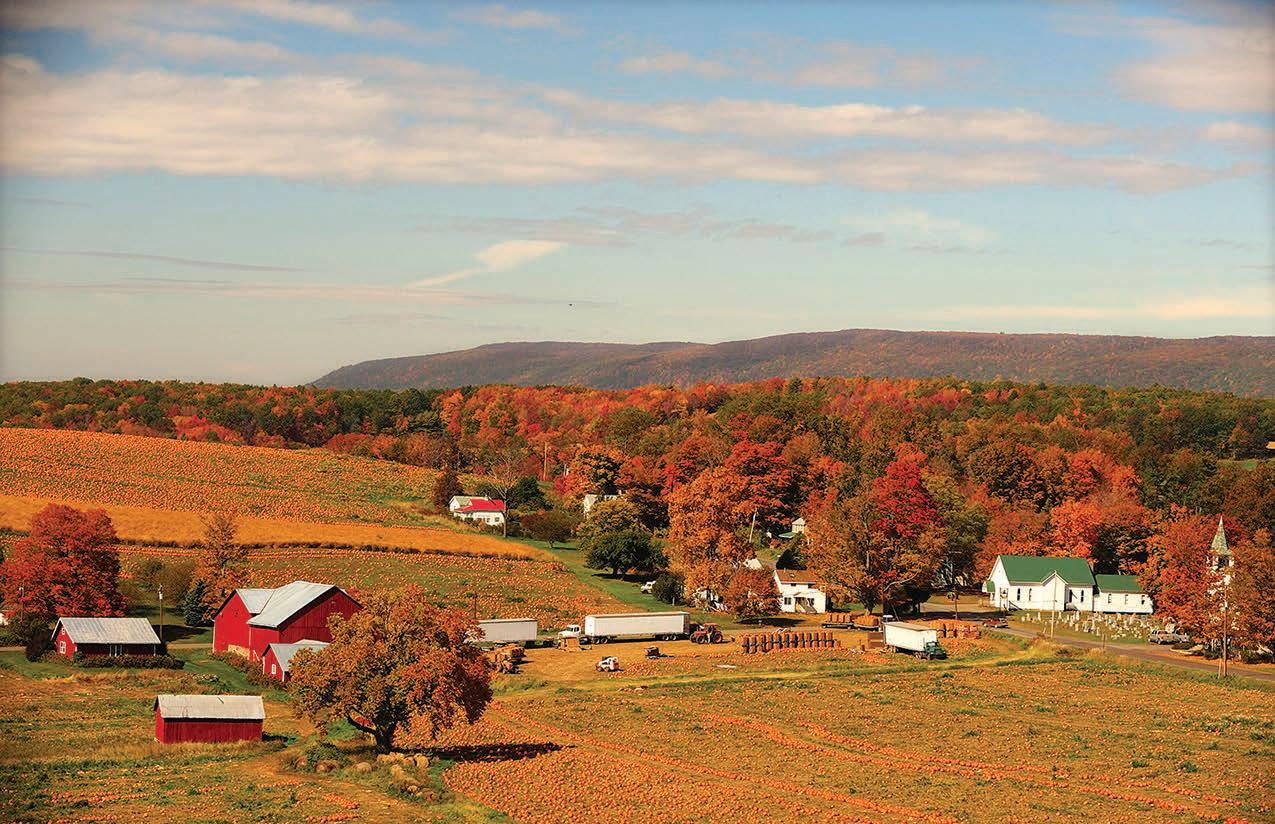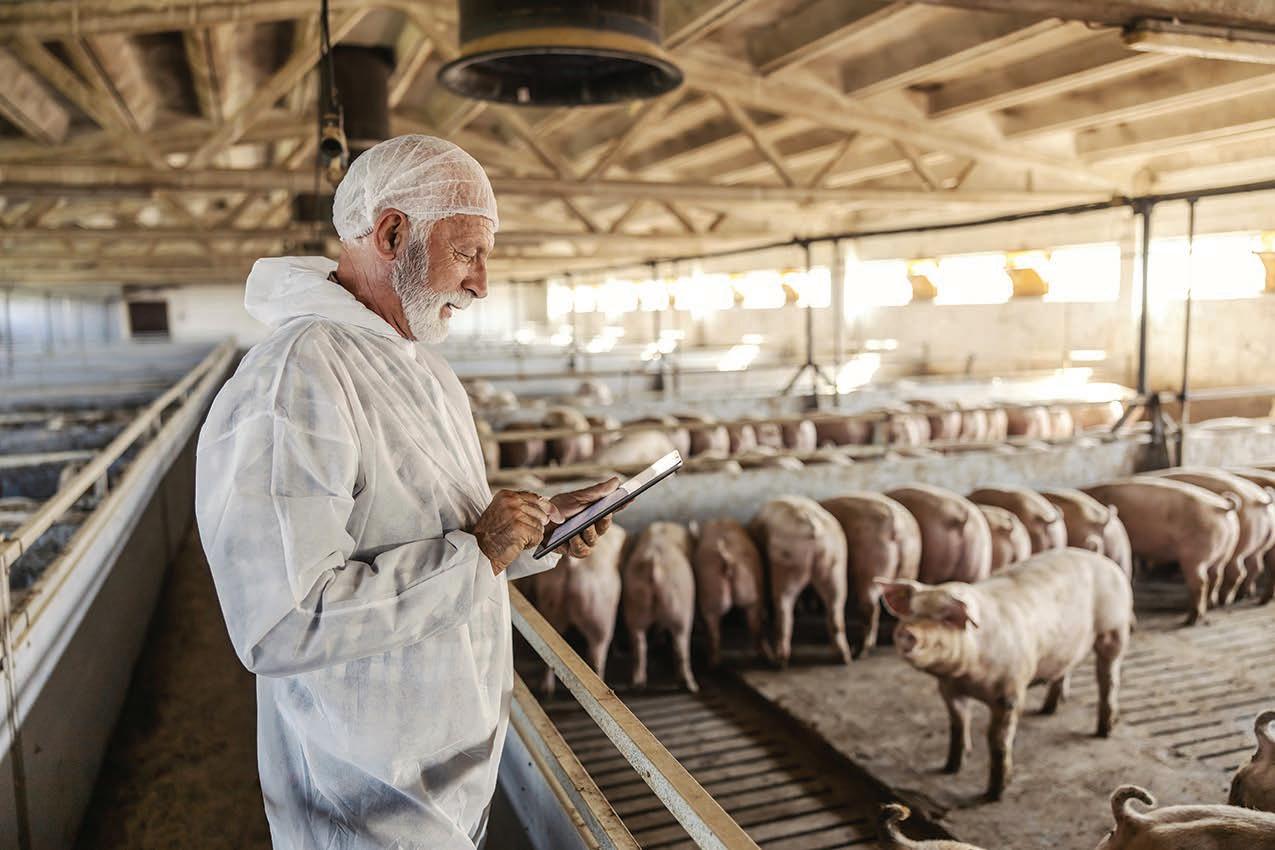Ag Matters Fall 2025

INSIDE
• The many ways a thriving agricultural sector is beneficial
• Apple picking pointers
• What consumers can do to support local farmers and more...



















• The many ways a thriving agricultural sector is beneficial
• Apple picking pointers
• What consumers can do to support local farmers and more...

















Inflation has been a hot topic for several years running. Many businesses have been forced to raise their prices in an effort to combat a host of variables, including materials costs, labor shortages and political uncertainty across the globe. That’s been hard on consumers’ and business owners’ pocketbooks, and precisely when inflation will simmer down remains a mystery.
Though the cost of many goods and services has skyrocketed in recent years, discussions about inflation often focus on the rising cost of groceries. According to USDA Economic Research, food prices in the United States rose 23.6 percent between 2020 and 2024. That’s led many people to cut back on luxuries like dining out. As people dine out less, they may be looking to expand their culinary horizons at home, and that goal is best achieved when the agricultural sector is put in position to meet consumer demands. Indeed, that link is just one of the many ways that a thriving agricultural sector benefits everyone.
• A strong agricultural sector greatly benefits the economy. Job creation is widely cited as a pathway to economic recovery, and a well-supported agricultural sector can create millions of jobs. The agricultural tech firm Sabanto estimates 2025 began with around 2.4 million unfilled jobs within the agricultural sector. A 2022 report from Maryville University indicated the agricultural sector contributes $7 trillion to the U.S. economy, employing as much as 10.3 percent of the nation’s workers. The link between a thriving agricultural sector and a strong economy is undeniable, making it a worthy endeavor to support policies that prioritize agriculture.
• A thriving farm is a productive farm. Modern grocery stores offer an abundance of healthy foods, and many of those foods are grown on farms. The Farm Bureau reports that a single acre of land can grow various crops, producing as much as 50,000 strawberries or just under 2,800 bushels of wheat. Consumers who enjoy visiting grocery stores that offer an array

of fresh, nutritious foods, including fruits and vegetables, should know that those options are only available when a thriving agricultural sector is prioritized.
• Farms are vital to production of other products as well. Maryville University notes a thriving agricultural sector is involved in more than just
food production. IFP Energies notes that bio-based chemistry uses raw materials derived from biomass, such as plants like wheat, corn and potatoes, to produce an array of products, including inks, dyes and detergents. So it’s not just the foods people eat that can be traced to a thriving agricultural sector. Bio-based chemistry also
is considered green because it promotes a reduction of the environmental impact of industrial production. There’s no shortage of reasons to support a thriving agricultural sector. Indeed, consumers from all walks of life benefit in myriad ways when the success of the agricultural sector is prioritized. TF253872
It can be bittersweet to say farewell to summer. Months of warm weather and sunshine are hard to beat and provide plenty of opportunities to rest and relax.
Just because summer has come and gone doesn’t mean the opportunity to enjoy recreation is in the rearview mirror. Fall is awash in opportunities to enjoy the fresh, inviting air and take part in the various activities that go hand-in-hand with this time of year.
APPLE AND PUMPKIN PICKING
Heading to a nearby orchard or farm and choosing fresh fruit is a hallmark of fall. In fact, these are some of the most popular places to visit on the weekends, as crowds of people clamber to grab their Granny Smith or Cortland apples. Call ahead to learn which varieties are ripe and plan to arrive early before the trees are picked clean.
Apple orchards and pumpkin patches can be dusty, muddy or messy, so dress accordingly for the environment, including closed-toe shoes you don’t mind getting dirty. Keep in mind that many of these establishments

are cash-only. Bring cash and expect to have your bounty weighed upon checkout.
September and October are prime months for grape harvesting, which means local vineyards may host special tours and events to take advantage of their growing season.
Fall also is a great time to visit a vineyard that offers tastings, as you can sit out in the sun and cool weather and enjoy a glass or two of the latest
vintage. Follow local vineyards on social media or get on their email lists to stay on top of upcoming events.
The gradual depletion of chlorophyll in tree leaves is responsible for the amazing and colorful display Mother Nature puts on each fall. Everyone is treated to vivid panoramas of reds, oranges, purples, and yellows, making them ideal all-natural photo backdrops.
Plenty of people travel to more rural
areas to witness leaves change color, and that means that country areas can get crowded. It always pays to plan a leaf-peeping excursion for early in the day to account for the possibility of traffic along the route. Make an entire day of it by seeing the sights, grabbing lunch, and hitting a farmer’s market while out and about.
Many towns hold off on their annual fairs and carnivals until the cooler months of the year. These are entertaining and boisterous events that can include everything from food and livestock contests to rides and amusements to musical performances.
As these fairs tend to last a couple of days to a week, it could be fruitful to look into whether they sell multiday passes at a discount, particularly if you plan to attend a few times and maximize the fun.
Opportunities for fun abound each fall. With inviting weather and calendars full of seasonal offerings, now is an ideal time to enjoy the great outdoors. TF259182






Visiting a local apple orchard and picking one’s fill of apples is a quintessential fall activity. Apple picking is an ideal way to spend time outdoors when the weather tends to be cool and pleasant. Gathering fresh-from-the-tree fruit to turn into favorite fall desserts like cobblers and pies is irresistible.
According to the Economic Research Service, Washington state is the leading apple producer in the United States. It is followed very distantly by New York and Michigan. Apples were first cultivated in Canada by early French settlers, with the first trees planted in Nova Scotia’s Annapolis Valley around 1633. Today, New Brunswick, Quebec, Ontario, and British Columbia have become strong players in the apple business. While other areas may not be apple meccas, those looking to pick their own have plenty of options across North American to enjoy this pastime.
Prior to an apple picking adventure, people can do a little preparation to ensure the afternoon is fun and fruitful.
• Do some research. Before individuals head out, they should do research into the available orchards and which apple varieties they specialize in. Ripening seasons vary, so certain varieties may not be available at all times. Call ahead to learn which apples are ripe and when.
• Visit early. The best apples are often available early in the season before the trees have been heavily picked over. It’s also a good idea to visit the orchard early in the day, which means cooler temperatures and smaller crowds.
• Dress appropriately. Orchards can be dusty, muddy and buggy. The ground also may be uneven. Individuals can wear comfortable clothes and closed-toed shoes that can get dirty. Also, they should dress in layers, as it can be chilly early in the day and then warmer later on.
• Pick correctly. Instead of yanking on the apples, which can damage the tree and apples, people should gently roll or twist the apple upwards from the branch. If the apple is ripe it will detach easily with stem intact.

• Avoid bruising. It’s wise to inspect the apples to make sure they are firm and brightly colored. Those with bruising or insect damage should be left behind.
• Don’t overload. Only pick what you need. Apples are delicate, and overloading the apples into bags can
crush or bruise the ones on the bottom. Plus, over-picking means that the apples may spoil before they can be eaten.
After a day at the orchard, apples can be stored unwashed in a cool, dark place, which will help them stay fresher, longer. TF259181








Astrong agricultural sector is vital to a healthy economy. Turbulence has affected local and national economies in recent years, and the global economy has endured its own ups and downs during that span.
Though there’s no one-size-fitsall solution to economic struggles, consumers can make a difference by supporting local agricultural producers. A 2022 report from researchers at Maryville University indicated roughly 10 percent of workers across the United States were employed in the agricultural sector, which the report also noted contributes $7 trillion annually to the national economy. Job creation and economic output are two major reasons to support local farmers, and consumers can do that in various ways.
• Shop local. The shop local movement can make a notable impact on local economies, and it affects more businesses than brick-and-mortar stores on Main Street. Locally owned restaurants and grocers often source their foods from local farmers, so patronizing such businesses supports those who set up shop on Main Street as well as the farmers who

stock their shelves and pantries.
• Purchase seasonal foods. The organization Green America, which offers advice on how environmental sustainability produces stronger economies, notes that purchasing seasonal foods is a great way to support local farmers. Farmers grow seasonal foods throughout the year to take advantage of natural con -

ditions. Consumers who alter their purchasing habits with the seasons by buying foods that are in-season are likely supporting local agricultural producers. Read product labels to determine where foods are coming from. Non-seasonal foods are likely imported from far away, which has a detrimental impact on the environment and local economies.
• Buy directly from local farms. Most consumers purchase their food from grocery stores near their homes, but it might be possible to purchase directly from local farmers. Farmers may utilize e-commerce tools to sell directly to local residents, and might even offer delivery services that are more convenient than driving to the nearest chain grocery store.
• Act as an advocate for local producers. Consumers have considerable power, and that power can be exercised in numerous ways. Supporting restaurants that source foods from local farmers is one way consumers can exercise their power. But consumers also can advocate for local farmers by supporting legislation and candidates that prioritize building and supporting a strong local agricultural sector. Consumers also can advocate for local farmers by sharing their experiences via social media, word-of-mouth recommendations or writing positive reviews through aggregators like Google Reviews.
A thriving agricultural sector benefits local economies, and consumers can do much to support the farmers who operate in their towns.
TF257017


Labor shortages can make it hard for any business owner to compete, and those working in the agricultural sector are no exception to that reality. The U.S. Senate Committee on Aging notes that the median age of farmers in the United States is 58, and more farmers are older than 65 than under 44. That doesn’t bode well for the future, but the labor shortages confronting the agricultural sector pose an immediate problem as well.
A January 2025 report from the agricultural tech firm Sabanto noted there are currently 2.4 million unfilled jobs within the agricultural sector. Labor shortages pose a unique challenge, but the following are some strategies agricultural operations can consider to overcome a lack of help.
• Look for ways to automate. Automation can be a lifeline that helps to meet the challenge of labor shortages within the agricultural sector. Modern technology enables completion of various tasks, such as water measurement and soil analysis, through the use of automated sensors or programs. Automation can allow farmers to direct their limited personnel resources toward
tasks that require hands-on work.
• Join forces with fellow farmers. Another potential solution is to pool limited labor resources with other farmers in your area. Farmers can work together to identify workers who can be trained as specialists and then transported to various sites to perform vital tasks each farm needs to survive.
• Cut down on field operations when possible. Reducing reliance on tasks that cannot be automated is another strategy to confront the labor shortage. For example, no-tillage farming methods require fewer personnel.
Seasonal farming that limits operations during times of year when the available workforce is particularly scant also can help navigate the labor shortage.
• Encourage local politicians to promote legislative solutions. Policy reform that prioritizes access to labor within the agricultural sector can serve both shortand long-term needs. Farmers can contact local politicians and let them know about the challenges facing the agricultural sector, offering invaluable feedback that can be used to write and




promote farmer-friendly legislation. The agricultural sector faces immediate and long-term labor shortages. Confronting that sizable challenge
may require a willingness to embrace new strategies and promote important policy changes in the years ahead.
TF253871








Small towns and rural communities may not always get the attention they deserve, and it’s easy for their needs to be eclipsed by larger cities. Small town needs are ever-changing and unique to their respective locations.
While some rural communities have experienced a downward trend between 2010 and 2020, the numbers are complex and not universally applicable. Still, many of these areas can use help, as they are facing steep population declines, according to FWD.us. This bipartisan political organization says in the last 20 years departures from rural counties outweighed new arrivals by 700,000 people.
Empowering rural communities and helping them grow comes down to some key areas of focus.
• Create a walkable Main Street. Planning boards can carefully consider where well-thought-out development should go. While it’s important to maintain the integrity of the rural community without too much building, having a walkable and attractive town center where businesses can thrive is key. Families can live close by to daily destinations, and this may encourage more people to relocate to or stay in these areas, according to the Environmental Protection Agency.
• Help for farmers. Government officials need to hear more about the challenges farmers face. Tom Vilsack, former Iowa governor and the U.S. Secretary of Agriculture during the Obama and Biden administrations, says programs like the Climate Smart Commodities Program can help farmers. This program pays farmers a premium for using sustainable agriculture tools, or practices that make use of innovative farm products that produce renewable energy. Farms that work

efficiently and lower the burden of labor on farmers are a boon for rural communities. U.S. Department of Agriculture statistics indicate the majority of farmers in the United States have to supplement their incomes with off-farm jobs because smaller farms simply can’t keep up to make ends meet. Fighting for policies that keep more money going to small farms can strengthen rural communities.
• Improve infrastructure and resources. Rural communities need

access to the right resources in order to thrive. Improving access to highspeed internet, for example, can bring new business and educational initiatives to rural areas and small towns. Lenders can be more receptive to local entrepreneurs to help stimulate economic growth and job creation in these communities, according to the professional development group StrengthenND. Priority also should be given to improving roadways so residents can safely get to and from
homes, stores and businesses.
• Protect open spaces. Rural communities can rally to protect the landscape and help preserve open spaces. Focus also should be placed on providing places for recreation, and not only for local residents. Such features can make smaller towns more appealing to tourists, which in turn can increase investments in the local economy.
Small towns and rural communities can use certain strategies to foster growth and sustainability. TF257018








Chicken is a wildly popular food source that contributes 90 percent of the world’s poultry meat production according to the Food and Agriculture Organization of the United Nations. Chicken lovers may wonder if white meat really is, as some suggest, a healthier option than dark meat. That answer is somewhat elusive, and a side-by-side comparison of the two conducted by a registered dietitian for EatingWell affirms that elusiveness. One cup of dark meat (3.4 grams) is higher in saturated fat than the same size portion of white meat (1.4 grams), and that’s arguably the reason behind the former’s reputation as a less healthy option than the latter. But some may note that the fat content in dark meat makes it juicier and therefore requires less seasoning than white meat. Chicken seasoning tends to be high in sodium, which can offset some of the nutritional benefits of white meat compared to dark meat, particularly since the sodium content in each type of meat is roughly the same (133 milligrams for dark meat, 104 milligrams for white meat). Individuals who have certain health conditions, such as diabetes and pancreatitis, should opt for white meat over dark meat because they have much to gain from eating a low-fat diet. Others can consult with their physicians to determine if their best option is white meat or dark meat. TF259165

For over 50 years, Peoples Company has been dedicated to helping clients buy and sell land with industry-leading service. Our experienced land professionals specialize in traditional listing services, public auctions, and online auctions nationwide. Peoples Company listens to client needs and leverages its full-service land transaction platform to deliver the highest caliber services to achieve client objectives with exceptional service, superior marketing, and extensive industry knowledge.



Drinking milk is a popular way to consume the amount of dairy recommended for a healthy diet. Milk is a rich source of 13 essential nutrients that can boost the immune system and fuel the body. Milk notably contains vitamin D and calcium, which helps maintain strong bones and can reduce the risk for a bone-thinning disease known as osteoporosis. Milk also contains vitamins A and B as well as potassium and protein. Milk helps keep teeth strong and healthy as well. The United States Department of Agriculture says that each person’s recommended intake of dairy depends on his or her age, gender, height, and other factors. Generally speaking, toddlers and children should consume between one and 2.5 cups of milk per day. Adults can benefit from about three cups per day. A cup is equal to 8 ounces. Health experts advise choosing nonfat or lowfat versions of milk and additional dairy products, as they are much more heart-healthy than full-fat options. Too much saturated fat in one’s diet can lead to high cholesterol and a greater risk for heart disease. If the idea of downing three glasses of milk is a turn-off, milk can be incorporated into recipes, such as smoothies, where its taste and texture is less prominent. Cheese and yogurt also count. Eight ounces of yogurt or 11⁄2 ounces of hard cheese is equivalent to one cup of milk in terms of nutrition, says a2 Milk®, a company that produces milk that may be easier on digestion. Individuals who have a lactose intolerance can choose milk products that do not contain lactose. TF256946

The agricultural sector continues to face unique challenges. Issues affecting the agricultural sector have a ripple effect that affects domestic food security and the economic strength of rural communities.
In order to adapt to the changing landscape, farmers need to identify strengths and weaknesses in their operations, and then collaborate with policyholders to create a more resilient agricultural sector that benefits all involved. The following are six notable challenges farmers face in modern agriculture, based on data from Verdesian, a nutrient use efficiency company; AgAmerica, an agriculture lending firm; and Pinion, a business advisory organization.
Finding and retaining skilled agricultural labor is a notable challenge. The aging farmer population coupled with labor shortages is a concern. There is a need for new talent in farming as older generations are retiring and younger ones are failing to fill in the gaps.
2. DEPLETION OF AGRICULTURAL RESOURCES
The global population continues to grow, which means the demand for food and other agricultural products is increasing. This puts a strain on the resources farmers rely on that may be in short supply. Farming utilizes a considerable amount of the world’s freshwater supply, and farmers must continually identify ways to manage water resources efficiently, including wastewater reuse initiatives. As fossil fuels also may be finite resources, the agricultural industry needs to pivot to

renewable energy alternatives, some of which may require considerable costs to retrofit current operations.
Although the cost of food is no longer as high as it was just a few years ago, consumers are still feeling the pinch at supermarkets and other retail stores. Shoppers may continue to tighten their budgets and spend less on food, which may translate into reduced demand for produce and other food products. The food price outlook is uncertain, and historical data indicates food price deflation only occurred once in the past 50 years. Farmers may have to adjust operations to produce more for less to be competitive in the marketplace.

4. TECHNOLOGICAL
It’s becoming increasingly necessary for farms to utilize new technologies and embrace automation. Some farmers may not be trained in the utilization and application of these technologies, and conversion to new farming practices may require education/skills to manage new tools, or the hiring of skilled technicians from a shrinking agricultural workforce.
5.
Climate change and extreme weather can have a notable impact on farming. Weather events like droughts, floods and storms have become more common and severe. Farmers are vulnerable to unpredictable conditions and crop yields.

6.
One only has to look to the recent avian influenza outbreak to understand the disruption illnesses can have on livestock. The disease has led to mass culling of infested flocks, which has caused widespread losses in chickens, financial burdens to poultry farms and disruptions to egg production that has driven up costs. Bird flu is not isolated to poultry, either. Avian flu can affect dairy cattle, causing decreased milk production and cow death. The need for cleanup procedures and biosecurity measures from these illnesses puts an added financial burden on farmers.
Modern farmers face many different challenges that require adjustment to meet consumer demands. TF257019
Individuals approach their careers in various ways. Some may aspire to climb the corporate ladder, while others may pursue a career that affords them ample personal time to spend how they see fit. Many individuals look for careers that afford them ample opportunities to work in the great outdoors, which could make the agricultural sector an appealing industry.
Talented individuals with an array of diverse skills dot the agricultural sector landscape, and the following are just a few of the many careers to consider within this vital industry.
• Equipment technician: Data from the career experts at Indeed indicates agricultural equipment technicians earn an average salary around $65,000 per yar. Agricultural equipment technicians maintain and repair existing machines and install new ones, among their many responsibilities.
• Purchasing agent: An agricultural purchasing agent buys products and raw materials at wholesale. Indeed notes that purchasing agents often must meet specific purchasing quotas for processors and work with various clients who supply an array of agricultural products. The national average salary for agricultural purchasing agents is around $51,000 annually.
• Warehouse manager: The receiving, shipping and storage of agricultural materials is overseen by a warehouse manager. Indeed notes that these professionals now routinely utilize artificial intelligence products to manage inventory. Warehouse managers must know and adhere to safety procedures and guidelines that dictate how materials and products are stored. The average salary of a warehouse manager is around $52,000 per year.
• Sales: Like every industry, the agri-

cultural sector requires talented sales personnel. Agricultural sales reps sell materials and products and identify the needs of potential customers. Agricultural sales reps may spend ample time on the road at trade shows.
Doing so allows them to identify customers as well as their needs and wants, and promote their own products and services. An ability to foster strong and trusting interpersonal relationships is invaluable for agricultural
Data from the Bureau of Economic Analysis indicates the significance of farms in relation to the gross domestic product of the United States economy. In 2023, farms contributed $222.3 billion, or roughly 0.8 percent of the nation’s GDP. Though that’s a significant contribution in its own right, it only tells a small part of the role farms and farmers play in establishing a healthy national economy. Additional sectors, such as the food and beverage industry and textiles, apparel and leather products, rely on the agricultural sector to contribute to their own success. Without a thriving agricultural sector, those industries would falter, thus creating a domino effect that could prove devastating to the nation’s economy. That link is why the BEA estimates the agricultural sector is an even bigger contributor to the nation’s GDP than it may seem. Indeed, the BEA indicates the agricultural sector, in conjunction with food and related industries, contributed around $1.54 trillion to the U.S. economy in 2023, a contribution that accounts for roughly 5.5 percent of the nation’s GDP. TF253873
• Environmental engineer: Environmental engineers play pivotal roles within the industry, and could become even more vital in the decades ahead as the effects of climate change become more apparent. Environmental engineers design and implement solutions that occur on agricultural sites, helping to address issues such as un-
healthy soil, insufficient drainage and inefficiencies, among other concerns. A career as an environmental engineer within the agricultural industry can be rewarding and lucrative, with Indeed noting that the average annual salary for this position is a little more than $77,000.
These are just some of the career paths individuals can consider as they explore the agricultural sector.
TF243759





















